Beef Rendang
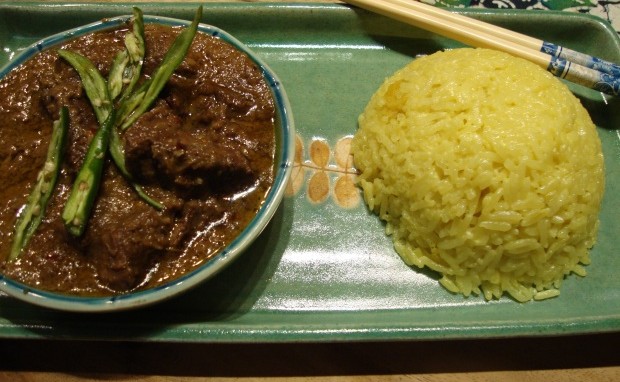
Almost 15 years ago I attended a Padang wedding in Bandung, Indonesia. I still remember that I tasted Rendang for the first time at the reception that followed the wedding and was totally blown away by the intense flavors that came together in this one dish! After that, every time I went to Indonesia, I would look for Padang restaurants and each time I would order Beef or Lamb Rendang with Nasi Kunyit (Rice with Turmeric). Back in Washington DC, I found a Malaysian restaurant that served a good Beef Rendang and this place has been a favorite of ours for years now. If you have never eaten Rendang, think of it as a slow cooked beef stew which is saturated with concentrated flavors of lemon grass, ginger, galangal, garlic, kaffir lime, coconut and several hot spices! The subtle taste of Nasi Kunyit (which is jasmine rice cooked in coconut water, kaffir lime and a pinch of turmeric) contrasts well with the explosion of flavors in the spicy Rendang.
Last week, my friend, Shilpa, brought me some fresh Kaffir Lime leaves that she has miraculously managed to grow in a pot in her house here in Washington DC. These are a rare commodity for me because I have never managed to find fresh Kaffir lime leaves in our area. I am sure Thai and Vietnamese restaurants have their suppliers bringing in this herb (since it is essential to these cuisines), but I have not had much luck finding them in the supermarkets here. Of course, right away, I thought of making Rendang with it – I wanted to use them in a recipe that would do justice to the precious gift!
I used a slow cooker to cook the beef cubes – it took well over 4 hours but believe me, the effort is well worth it! The recipe looks long and complicated but it is not that complicated because for most of the time, the beef cooks by itself in the slow cooker and it does not need constant supervision.

Ingredients:
1. 1-1.25 lbs of boneless beef cubes (meant for beef stew)
2. 4 cloves of fresh garlic
3. 3 medium sized white onions (or 10-12 shallots)
4. 1 inch long fresh ginger root
5. 1 inch long fresh galangal root (I could not find any today, so I did without it and the dish came out okay without it as well)
6. 3-4 stalks of lemon grass
7. 5-6 fresh Kaffir Lime leaves
8. 2-3 fresh green or red chilies
9. ¼ cup of grated desiccated coconut
10. 1 can of coconut milk (12.5 fl oz)
11. 1 tablespoon of tamarind paste/concentrate (available at Indian or Asian stores)
12. 1.5 tablespoons of coriander seeds
13. 1 tablespoon of cumin seeds
14. 2 teaspoons of turmeric powder
15. One stick of cinnamon
16. ½ a nutmeg
17. 5-6 cloves
18. 2-3 teaspoons of powdered red pepper
19. 2 tablespoons of cooking oil
20. 1.5 tablespoons of sugar
21. Salt to taste
Directions:
1. Peel and roughly chop the onions/shallots.
2. Peel and roughly chop the garlic cloves, ginger, lemon grass, Kaffir lime leaves and galangal.
3. Dissolve the tamarind paste in ¼ cup warm water.
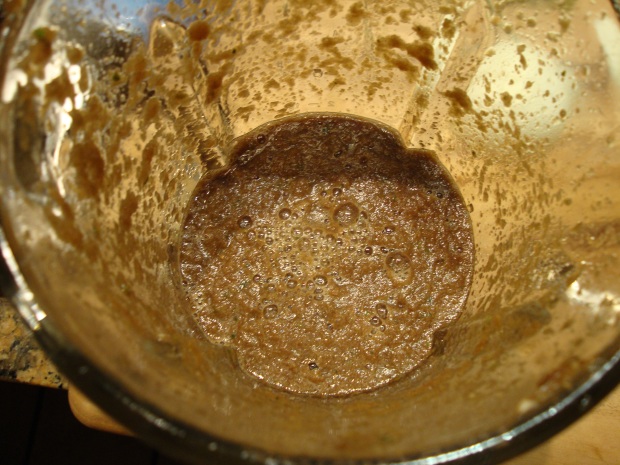
4. Make a wet paste by completely grinding the following ingredients in a blender: chopped onions, green/red chilies, ginger, garlic, galangal and the dissolved tamarind liquid.
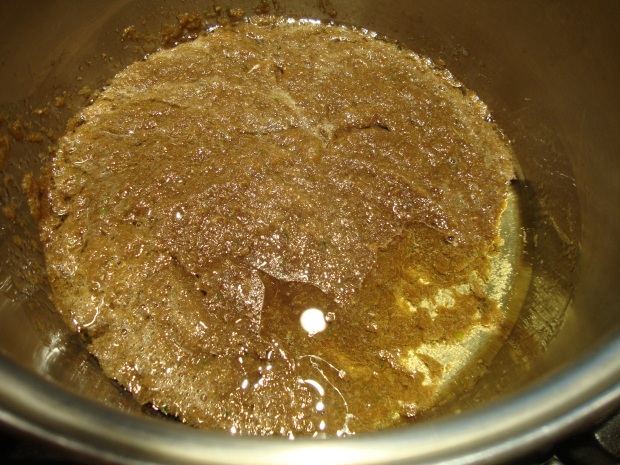
5. In a large pot, heat up the cooking oil and then add the wet paste from the blender into it and start cooking it on low heat. Stir frequently to prevent burning at the bottom of the pot.

6. While the wet ingredients are cooking, grind the following dry ingredients in a spice grinder: cumin seeds, coriander seeds, turmeric powder, red chili powder, ½ nutmeg and 5-6 cloves. This powder should be completely even and thoroughly mixed. Also add salt and sugar to this mixture.
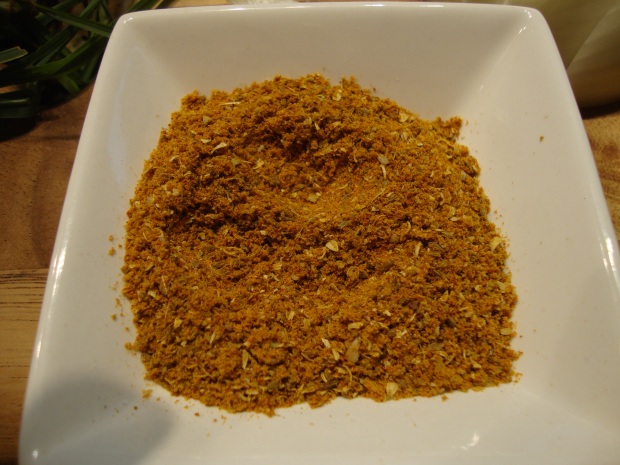
7. Continue cooking the wet ingredients over low heat and stir regularly.
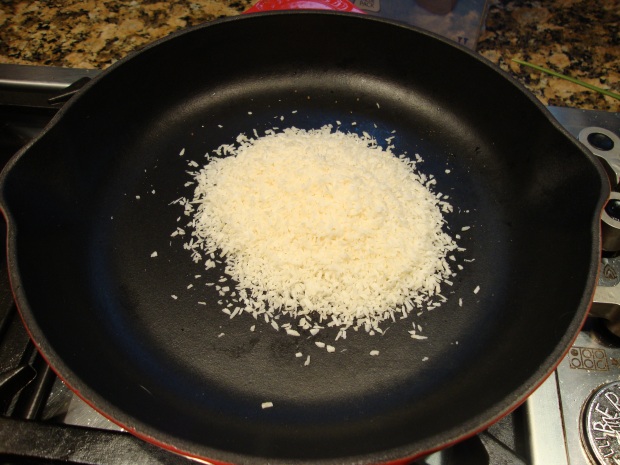
8. In a cast iron skillet, brown the coconut flakes (over low heat) – this takes 2-3 minutes and continue to stir these constantly or the coconut flakes get burnt easily.

9. After cooking the wet ingredients on low heat for 10 minutes or so, add the meat and the dry ground spices to them and stir the contents of the pot and let them continue cooking on medium heat for another 10 minutes or so.
10. Transfer the wet ingredients from the pot to an electric crock pot (set at high) and add the browned coconut flakes and a can of coconut milk to it as well.
11. Set the crock pot to cook for 3-4 hours. Continue to check on the meat every hour or so to ensure that there is enough liquid to continue the cooking process without burning the dish. If it looks too dry, add a little bit of warm water and then cover and let the meat cook. Ultimately the meat should be fork tender – this usually takes 4 hours (depending on the heat of the crock pot).
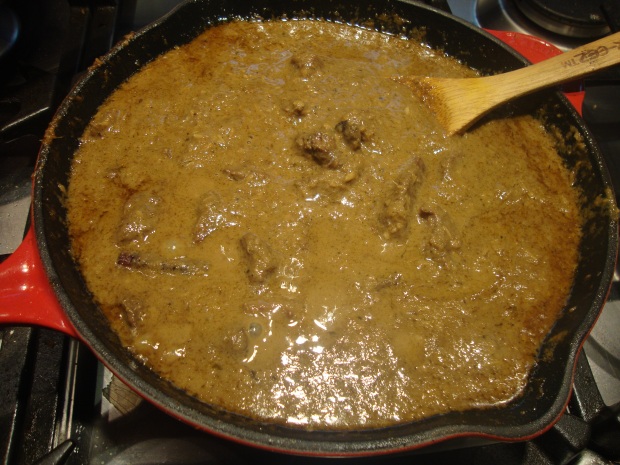
11. When the meat is fork tender, transfer the contents of the crock pot to a cast iron skillet to evaporate any excess liquids in the dish. The Rendang has a thick sauce (almost past-like consistency), so if there is too much liquid, continue to cook the dish in a skillet (uncovered) to evaporate the liquid.
12. Serve the Beef Rendang with Nasi Kunyit (I made it in an electric rice cooker with a cup of rice, one cup of coconut milk, one cup of water, two leaves of Kaffir Lime, 2 teaspoons of turmeric powder and salt to taste).
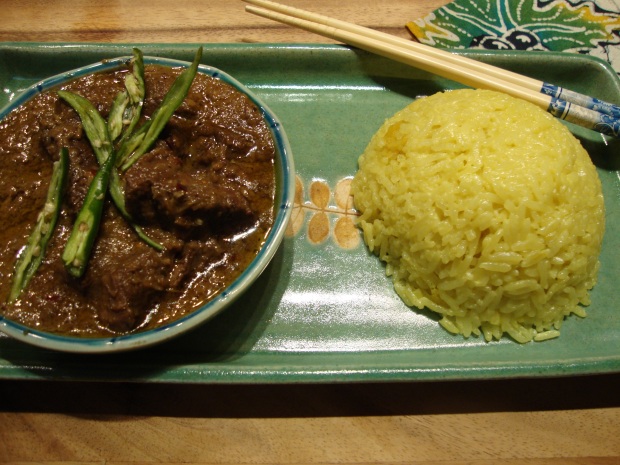 107
107




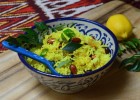



Excellent recipe, very easy & quick to put together, all ingredients in good proportions, so end result is delicious.
HEy Gabriela – nice to see you here 🙂 I am so happy your dish came out well – your feedback made my day!
Your beed rendang sounds wonderful and I will try it for sure. I am so glad that you found a good use for the kaffir lime leaves – now let your imagination soar! I added them to a soup the other day and the result was delicious – a subtle lemony flavour that just pulled everything together. They freeze quite well – just freeze the individual leaves in a ziploc bag.
Yes Shilpa – the beef rendang was out of this world – Shakeb said it was one of the best things that I have ever made – so that was high praise indeed. Thanks for the Kaffir lime leaves – I did freeze them and will continue to experiment with them. What kind of soup did you add them to?
I am so happy I stumbled upon your website looking for a delicious beef rendang to try for our family. I love your simple and easy step by step directions. Thanks for also clarifying the process for preparing the coconut. I look forward to keeping in touch. Take care, BAM
HEYYYYY!!!! Do try the recipe – this is one of my favorite dishes 🙂 BTW I add some sugar to balance out the tamarind but if you don’t like it sweet and sour, reduce the sugar amount! Let me know how yours turns out! Would love to hear from you!
I want to make this now!
Hey Daphne – if you try it, let me know how it turns out! It looks complicated but actually it just needs slow cooking otherwise it is easy and tastes great!